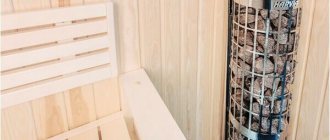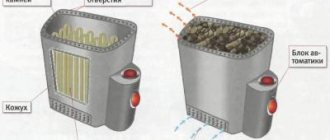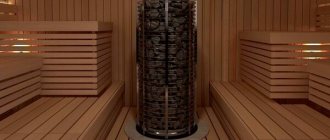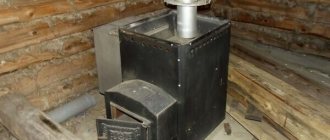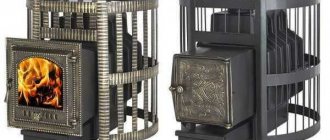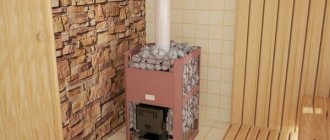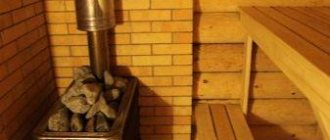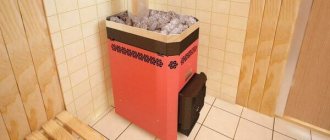3.4/5 — (5 votes)
When I started my activity in the bathhouse industry, I was told that these were excellent stoves that were ideal for Russian baths. Most clients, when they learned about the cast iron component of these stoves, were 80% ready to buy.
In most cases, selling this stove is not difficult. Today we’ll talk about a stove, or rather a series of stoves, which has a lot of reviews on the Internet, both positive and negative. Shrouded in many myths, superstitions, slander and inaccurate information, a series of stoves, Vesuvius, Legend companies.
So, I recently wrote about ]Vesuvius[/anchor], and briefly talked about the company’s line. Today we’ll take a closer look at cast iron stoves.
Distinctive features
Cast iron heats up more slowly than steel, but its properties are superior to all materials . During the operation of the furnace, burnout occurs more slowly. The case retains heat for up to seven hours. Cast iron is an alloy of iron and carbon, making it resistant to corrosion and resistant to high temperatures.
Silicon and manganese in the composition make cast iron more durable and ductile.
The structural elements of the furnace are combined into a single structure by welding . All joints are treated with sealant. The operating principle of cast iron stoves is the same. It comes down to heat transfer indicators and heat retention time. This is what distinguishes cast iron from other materials.
The stones are placed on top, and the water tank goes around the pipe and the stones. This ensures minimal heat loss.
Firewood is thrown into the firebox. When they burn, a hall is formed. It pours into a special compartment. Next, the hot air rises, and the stones are heated by the stove and pipe. The temperature in the pipe reaches 250 degrees Celsius . The stones give off heat to the room, thereby creating a comfortable environment.
Installation subtleties: what do you need to know?
It is better to install “Kalita” with a ceramic chimney, so that later it can be lined in the same color as the stove. Although you can do it differently - use the top cover of the furnace as a support for lining a single-layer pipe.
If “Kalita” is placed flush with the floor, then the floors will warm up even in neighboring rooms - thanks to a good firebox.
The Kalita Russian Steam stove is especially beautiful, lined with soapstone - an impeccable and stylish material with unique physical and mathematical properties. This stone completely replaces brickwork and emits soft, velvety heat into the steam room, which does not burn the respiratory tract or skin. Moreover, it lasts for several hours in a row, making bath procedures especially pleasant - which is why the domestic Kalita stove is good for a Russian bath.
Advantages and disadvantages
Cast iron stoves are considered the standard. They are much more practical than stone, steel and other units. This is due to the optimal composition, design features and build quality.
Advantages:
- simple installation;
- cheap fuel (firewood);
- compact dimensions - usually the stoves are small, so they can be installed even in a small room;
- installation does not need to be coordinated with interested organizations, unlike gas boilers;
- the oven reaches the desired temperature much faster compared to electric and gas appliances;
- the housing is highly sealed;
- products are resistant to high temperatures (steel deforms over time);
- the water in the tank remains hot for up to 4 hours;
- service life is more than 30 years, which is not typical for stoves made of other materials.
Flaws:
- you need a stronger foundation than when installing a steel stove;
- unlike an electric boiler, it is necessary to make a chimney;
- despite the massiveness, the material is fragile, so you need to be careful when installing;
- the price of cast iron stoves is higher compared to steel and other units;
- Sudden cooling is not allowed, otherwise the cast iron will crack.
Operating rules
When operating a Sudarushka cast iron stove, it is strictly prohibited:
- Use flammable liquids for combustion.
- Use coke, liquid and gaseous fuels, coal, peat as fuel.
- Use firewood that does not fit completely into the firebox.
- Dry clothes or shoes near the equipment.
- Operate the oven with the tank empty of water.
- Remove soot by burning.
- Engage in cleaning, remove ash from the stove, which has not yet cooled down after use.
- Change the design of equipment yourself.
- Use the stove in rooms where fire safety requirements are violated, for example.
- Use the equipment for more than 6 hours a day and raise the temperature above 110 degrees.
- Use the oven without an external brick fence.
To avoid problems with the operation of the stove, it is also prohibited to install it in residential premises - the unit is produced exclusively for bath rooms. When starting up the equipment, it is necessary to ensure that water flows onto the stones in small quantities. If you overdo this process, the resulting steam can cause serious burns on your body. It is not advisable to cover the stove with various objects on top, since a fire may occur.
If you notice that the structure is damaged, you should call a specialist and, if necessary, have the equipment repaired. To prevent the door from deteriorating, the tunnel space must not be used as a firebox.
By following all the operating rules, you can avoid many problems and fully enjoy your relaxation in the bathhouse, sauna or steam room. The Sudarushka sauna stove is an ideal device for heating this type of premises.
What to choose and which one is better?
Stoves for baths and saunas are made of cast iron, heat-resistant steel or alloyed stainless steel . Materials differ in carbon content. The ductility and strength of steel and cast iron is due to the low carbon content (2%). Each option has its own characteristics and disadvantages.
The main advantages of a cast iron stove:
- Thermal conductivity . The indicator is much better than that of structures made of brick and steel, which deform due to temperature changes. The efficiency of a cast iron stove is 82%. After one load of firewood it works up to 7-9 hours. The weight is up to 300 kg, which eliminates the need to install a foundation on it.
- Easy care . If you install a cast iron stove, you don't have to spend a lot of time maintaining it. The product does not rust and does not require special paint. Due to the absence of cladding, the unit is easy to install and, if necessary, dismantled for transfer to another location. Steel products need to be treated with heat-resistant paint, and this should be done once a year.
- Design . For this reason, both steel and cast iron stoves attract buyers. The range is represented by a variety of models, which allows you to find the right option. The ovens are equipped with doors made of heat-resistant glass. Various forged elements give the stoves a sophisticated look.
- Safety in operation . Compared to brick stoves, cast iron products are safer to use, as they are less likely to cause fire.
- Lifetime . One of the main features of cast iron stoves. With proper use, the service life exceeds 35 years.
The only disadvantage of a cast iron stove is the high price . But products from domestic manufacturers are cheaper. At this quality, it is no worse than that of Swedish and other manufacturers.
Is the quality of cast iron the same among different manufacturers?
Oddly enough, but cast iron is different from cast iron. This metal can be very different in its chemical composition. And, if its production was unscrupulous, then during the use of such a stove even cracks may form. And in Russia, according to experienced stove makers, high-quality cast iron is not produced at all.
Much more enthusiastic reviews today are received by units from the Swedish company Keddy, in which the fireboxes are solid cast iron. The doors are fitted manually, without a seal, and the chamber is completely sealed. If used correctly, such a furnace will never burst - after all, such products are made using the centrifugal method, and from special cast iron, the secret of the composition of which the Swedes still keep secret.
But ordinary cast iron is really afraid of thermal shocks, it’s true. It can burst if the temperature difference between its two nearby points is more than 80 degrees. For example, this can easily happen if cold water gets on such a stove in a bathhouse, which is not at all uncommon. That is why almost none of the leading manufacturers make cast iron sauna stoves, and the domestic Sudarushka will serve for a long time only if treated with extreme care.
However, every thing has its own lifespan, and just because a cast iron stove holds heat well, you can turn a blind eye to all its other disadvantages.
How to choose a cast iron stove and what to look for?
The range is represented by a huge selection of models . The buyer decides which one to choose based on individual needs and financial capabilities. To find a suitable option, you should read the recommendations.
Stove selection criteria:
- Placement of the firebox . It can be regular or extended. The latter is installed in the wall opening. This allows you to heat the stove not from the steam room or from the rest room.
- Tank type . The design can be built-in or wall-mounted. When choosing, you need to focus on the specifics of the bath.
- Productivity . This indicator is indicated in the product passport. It determines how quickly the room warms up.
- Door type . Models with a tempered glass door are more expensive, but simpler products are not inferior to them in quality.
- Material . Some manufacturers replace some of the elements with steel ones to reduce the cost of their products. The disadvantage is that the service life of the oven is significantly reduced.
- Heated volume . The indicator is indicated in the product characteristics. It is worth focusing on the area of the room.
- Ash box . Most modern models have a built-in box where combustion waste is collected.
Rating from users
It is also worth reading the rating in the article about which sauna stove is better and about the best wood-burning stoves.
Additional useful information about sauna stoves:
- Inexpensive;
- How to install;
- How to install models with an external firebox;
- How to install in a steam room.
*** Finally, let’s add that good fireboxes are approximately the same - the market is small, everyone has long adopted the best from each other. Therefore, focus on an experienced manufacturer and you won’t go wrong.
TOP 7 best cast iron stoves for baths and saunas
When choosing a product, you should take time to study the characteristics of different models. When comparing, it is easier to understand which oven will be most suitable. The rating includes seven stoves from different manufacturers. Each of them has its own characteristics, advantages and disadvantages.
Hephaestus PB-04 MS
The products are made of alloy cast iron. The thickness of the parts is 40 mm. Due to its unique shape, the oven heats up to 500 ⁰C in a short time. Convection fins on the side mounts increase heat transfer. Despite the thickness, the unit quickly distributes steam.
Characteristics:
- dimensions - 39.40x56x64.50 cm;
- weight - 130 kg;
- heated volume - 15 m³;
- power - 8 kW;
- type - closed;
- Efficiency - 87%;
- secondary afterburning - yes;
- ash box - yes;
- chimney diameter - 11.5 cm.
Advantages:
- completely made of cast iron;
- spacious ash drawer;
- glass door;
- optimal size;
- convenient connection to the chimney;
- holds up to 180 kg of stones.
Flaws:
- high price;
- complex installation.
Hephaestus PB-04
High-quality stove made of alloy cast iron . Due to its unique design, it quickly warms up to the desired temperature, which ensures fast steam distribution. The side walls are equipped with convection fins, which increase heat transfer from burning wood.
Characteristics:
- dimensions - 39.40x56x64.50 cm;
- weight - 130 kg;
- heated volume - 15 m³;
- power - 8 kW;
- type - closed;
- Efficiency - 87%;
- secondary afterburning - yes;
- ash box - yes;
- chimney diameter - 11.5 cm.
Advantages:
- spacious compartment for stones and firewood;
- environmental friendliness;
- long service life;
- attractive appearance;
- high-quality case;
- built-in ash drawer.
Flaws:
- difficulties with installation (formation of a reinforced base);
- high price.
Vesuvius LEGEND STANDARD 16 (DT-4S)
The stove from the Russian manufacturer is extremely popular . The manufacturer uses high-quality materials to manufacture products. The stove heats a large room in a short time.
Characteristics:
- dimensions - 56x70x69 cm;
- weight - 117 kg;
- heated volume - 18 m³;
- power - 16 kW;
- type - closed;
- secondary afterburning - yes;
- ash box - yes;
- chimney diameter - 12 cm.
Advantages:
- weight of stones up to 120 kg;
- stylish design;
- glass door;
- high efficiency;
- fast heat transfer;
- easy care;
- glass self-cleaning system.
Flaws:
- some elements are made of steel;
- a protective coating must be applied.
Vesuvius LEGEND FORGING 16 (270)
When manufacturing furnaces, the manufacturer controls every stage: from the extraction of raw materials to packaging of products . Due to this, the stoves are of high quality. Model LEGEND FORGING 16 (270) has an attractive appearance.
It is characterized by high heat transfer. The thickness of the firebox walls is 1.2 cm.
Characteristics:
- dimensions - 56x70x69 cm;
- weight - 98 kg;
- heated volume - 18 m³;
- power - 16 kW;
- type - closed;
- secondary afterburning - yes;
- ash box - yes;
- chimney diameter - 12 cm.
Advantages:
- all-welded construction;
- spacious ash drawer;
- high efficiency;
- heat-resistant glass door;
- remote firebox.
Flaws:
- corrosion;
- the need for treatment with a special compound.
Vesuvius Sensation 16 Anthracite (270)
The manufacturer is constantly improving models. Cast iron stove Vesuvius Sensation 16 Anthracite (270) has optimal characteristics. Quickly warms up the room due to the dense walls.
Characteristics:
- dimensions - 41x64x69 cm;
- weight - 99 kg;
- heated volume - 18 m³;
- power - 16 kW;
- type - closed;
- secondary afterburning - yes;
- ash box - yes;
- chimney diameter - 12 cm.
Advantages:
- Beautiful design;
- capacity up to 60 kg of stones;
- convenient ash drawer;
- high efficiency;
- heat-resistant door;
- minimal load of stones on the collector;
- self-cooling and self-cleaning system;
- high quality coating.
Flaws:
- overcharge;
- installation difficulties.
Vesuvius RUSICH ANTHRACITE 22 (DT-4) 2016
High-quality model that meets European quality standards . A closed stove equipped with a chimney. The wall thickness is 0.8 cm, which ensures rapid distribution of heat and steam.
Characteristics:
- dimensions - 56x73x69.50 cm;
- weight - 99 kg;
- heated volume - 14 m³;
- power - 16 kW;
- type - closed;
- secondary afterburning - yes;
- ash box - yes;
- chimney diameter - 11.5 cm.
Advantages:
- quality material;
- durable cast iron door;
- optimal size;
- convenient connection to the chimney;
- it is heated from the next room;
- colorful appearance.
Flaws:
- holds 40 kg of stones;
- complex installation.
KASTOR Karhu-16 JK
Finnish stove made of alloy cast iron . Durable product. It warms up the room perfectly and maintains a high temperature for a long time.
It has a simple design, making it suitable for any room style.
Characteristics:
- dimensions - 43.50x71x49 cm;
- weight - 59 kg;
- heated volume - 16 m³;
- power - 16 kW;
- type - closed;
- secondary afterburning - yes;
- ash box - yes;
- chimney diameter - 10.4 cm.
Advantages:
- quality material;
- high level of productivity;
- compact size;
- beautiful design;
- high power;
- easy cleaning.
Flaws:
- high price;
- glass door.
Main characteristics of Legend series furnaces.
Legend 22 stove cross-section
The Legend series sauna stoves are divided into four groups by volume:
- Legend 12 – from 6 to 14 m3
- Legend 16 – from 8 to 18 m3
- Legend 22 – from 12 to 24 m3
- Legend 28 – from 14 to 30 m3
All groups differ only in the dimensions of the furnaces. Not by a smoke damper system or any other design changes, but simply by size. The stove is created according to the complete classics. Three parts of the furnace are screwed together. Between the parts there is a ceramic cord and a heat-resistant sealant.
The oxygen supply system is regulated by the ash pan and, in some cases, by doors. Let’s say that on doors numbered 205 and 224 there are blower dampers, thanks to which a pseudo-system of clean glass and regulation of the oxygen supply are carried out.
Legend series standard
There is also a grid distinction. In the “legend forging” series, the series is made with forging elements, and also contains the most interesting doors. And in the cheaper series (standard) the doors are ordinary. So the company differentiated essentially the same stoves, without any special changes, into premium and economy.
Is this fair? I think no. In fact, if you want a large glass or a hermetically sealed door, you are required to overpay for a forged mesh painted with bronze paint.
As I wrote earlier, the smoke tooth system in sauna stoves “legend” is primitive. In fact, this is an ordinary curved plate, thanks to which non-exhaust gases are slightly retained in the chamber before leaving the furnace. Simply put, we are not talking about the complex system that is installed on Feringer furnaces or the rather good systems of the Teplodar company.
But the indisputable advantage of the simplicity of such a tooth is cleaning the chimney. You move this tooth to the side, or remove it altogether, and get direct access to the chimney.
Consumables
To work at high temperatures, all materials must be heat-resistant. The durability of the structure depends on this.
Brick.
In terms of fireproof properties, fireclay and ceramic solid bricks of plastic molding M250 and higher are suitable for lining. It is advisable to take the entire volume of bricks from one batch.
Covering a metal stove with bricks located in a residential area should have an aesthetic appearance. You can use ordinary bricks for plaster or cladding; if finishing is not planned, it is better to use facing blocks with a smooth or textured surface.
Solution
Standard cement-sand mortar cracks due to intense heat and spills out of the masonry. For furnace work, a clay-sand solution is used in a ratio of 1 to 1 – 1 to 2. You can prepare such a solution yourself.
The strength of the resulting solution will depend on the correct ratio of components. One of the characteristics of clay is fat content - the higher it is, the more sand you need to add.
Ready-made dry mixtures, which are sold in construction markets, simplify the choice of solution. Their price is not high, and purchasing them will save you from unnecessary hassle. The attached instructions give the recipe. Usually it indicates the amount of water for diluting the mixture and the time for the solution to harden at different temperatures.
Reinforcing mesh and metal profile
In some cases (large area or small wall thickness), the masonry is reinforced with reinforcing mesh. The required strip width is cut in advance.
A corner or strip is needed for jumpers if the stove is lined on all sides.
Waterproofing and heat-resistant thermal insulation material
A waterproofing layer is placed on the concrete base under the stove to prevent the brick from becoming damp. For this purpose, roofing felt or similar material is used. Thermal insulation is made with asbestos.
Vesuvius water tanks
In the basic configuration, Vesuvius stoves are not equipped with water tanks. But you can choose any of those that are in production. Vesuvius produces various tanks:
- Rectangular pipe tanks (55 and 80 liter capacity) and rectangular wall-mounted tanks (60, 80, 110 and 125 liter capacity).
Rectangular tanks for the Vesuvius pipe
All of them are welded from matte stainless steel sheets 1 mm thick. G3/4 fittings are located on the bottom or on the sides. - Oval pipe tanks (55 and 80 liters), vertical and horizontal contour oval tanks (60 and 90 liters) made of mirror stainless steel 1 or 0.5 mm.
Oval tanks for the Vesuvius pipe
Mounted oval tanks “Vesuvius” made of mirror stainless steel.
There is a filler hole and G3/4 fittings located on the side. - Heat exchangers are round (volume 6 and 12 liters) and flat. They are made of stainless steel with a thickness of 1 or 0.5 mm, two G3/4 fittings for connection to the heating system or water supply.
Ermak, model No. 12, former “Gnome”
The design developers were not particularly looking for an original name for the updated model. The smallest stove Ermak 12, dimensions 70x40x40 cm, is capable of producing heat equivalent to 12 kW of power. This is enough for a tiny steam room of 4-5 m2.
When choosing a stove for a bath, you need to take into account the features of the firebox and heater:
- The depth of the combustion chamber is 50 cm, this model fits three standard logs, so loading with fuel when heating the bathhouse will have to be done at least twice;
- The weight of the stones is about 40 kg, which is enough for a comfortable steam build-up, but the stove cools down too quickly, so you will have to use the built-in supply and exhaust ventilation to dry the steam room.
The stove is ideal for built-in indoor sauna premises, it is easy to transport to the country house, the model is easy to maintain and clean from ash and dirt. The price for Ermak 12 in a new design is from 12 thousand rubles. Experts advise choosing models with an attached tank for a bathhouse, they are more convenient and practical to use.
DIY making
In order not to spend money on buying a new cast iron stove, you can make it yourself. To do this, you need to prepare tools, materials, carry out preparatory work, and perform step-by-step assembly.
Tools and materials
Before starting work, you need to prepare materials and tools:
- Wheel rims - 4 pcs.
- Cast iron sheets - the quantity depends on the size and complexity of the design. The thickness of the sheets should not be less than 3 mm.
- Red brick - about 300 pieces.
- Sand, crushed stone, cement.
- Metal pipes.
- Grinder, set of wrenches, drill with drill bits.
- Metal corners.
Preparatory work
Prepare a drawing on which the main elements of homemade furnace equipment will be marked. On it indicate the dimensions and joints of individual parts.
If the structure is massive, it is necessary to make a separate foundation. It is built together with the main one and must exceed the dimensions of the stove by 30 cm on each side. The foundation is made from a solution based on cement, sand, and crushed stone. Additionally, it can be reinforced with reinforcement.
conclusions
Despite the negative reviews, it cannot be said that all stoves are of low quality. When choosing a sauna stove, it makes sense to look into a store with an “understanding person” so that you don’t bite your elbows after the purchase.
If you are limited in funds, but want to buy a stove with thick walls (8-10 mm), then you can take a closer look at stoves. Despite the fact that Zhara stoves are made of pipes and look like a steam locomotive, they are quite reliable. After covering the stove with brick, everything looks quite aesthetically pleasing.
If you have a piece of pipe of suitable diameter and a welding machine, you can make a sauna stove yourself.
If you are willing to pay for quality, check out Finnish-made stoves.
Is a closed or open heater better?
We have not yet mentioned that there are open heaters. This is when the stones have direct contact with the air in the steam room. This is exactly how many people imagine a steam room: there is a stove with a beautiful pile of stones on top, water is splashed on them and excellent steam is produced.
To be honest, the steam you get is disgusting - heavy, thick, opaque, and most importantly - the least needed in both a Russian and a Finnish bathhouse. The Finns pour little water to keep the air dry enough - at the high temperatures they like, high humidity will simply boil a person and give him a heart attack. But in a Russian bath, steam is needed of a completely different quality - overheated, with a temperature of more than 100 degrees. And it is impossible to get it from open stones. At least without a steam gun.
So why are open heaters made? But the reason for their popularity is completely different - they provide heating to the room. You can quickly heat a steam room with a stove with metal walls; stones are needed so that the convection is long and continuous.
So it’s difficult to say whether a closed or open heater is better; it depends on your goals. The same goes for choosing the best stove.
By the way, there are stoves where both are present. Is it good? The presence of a closed one indicates that the owner is not alien to the joys of a Russian bathhouse, but it requires fully controlled convection, and an open one does not provide control options. On the other hand, a closed one is not needed in a sauna. So such stoves are a marketing ploy, adding options without taking into account the specifics of a particular mode.
Do you want an ersatz Russian sauna with an open heater? Take a steam generator (more about it here). You can quickly heat up the steam room using a conventional stove, and the steam generator will quickly produce light, finely dispersed steam. Will it be “tasty”? It's not the same for everybody. And if you want sauna mode, just don’t turn on the steam generator and that’s it. This is exactly how we understand “an oven with different modes.”
